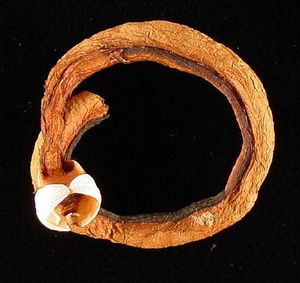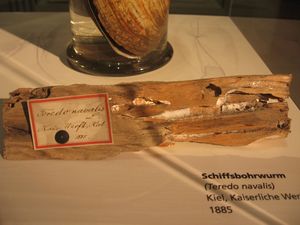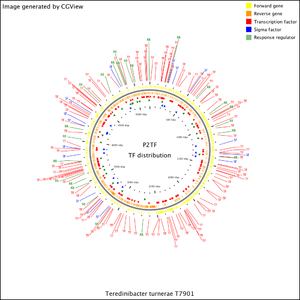Teredinibacter turnerae
Characteristics of the symbiont/pathogen
Teredinibacter turnerae is a member of the proteobacterium family, and is a gram-negative rod with a single polar flagellum used for mobility.[2] The genome of T. turnerae has been completely sequenced, containing 5,192,641 base pairs containing over 100 genes implicated in the digestion of plant polysaccharides. [2] It is closely related to Saccharophagus degradans, another bacterium that is capable of digesting cellulose. Unlike S. degradans, which digests primarily aquatic polysaccharides, T. turnerae encodes genes that are primarily specialized in the degradation of terrestrial polysaccharides. [4]
Characteristics of the host
The host Lyrodus pedicellatus, commonly known as "shipworms" because they digest the wood immersed in salt water, are small salt water clams with small shells. Even though they resemble worms, they are not actually worms, but mollusks. There are 300 species of Teredindiae, the shipworm family, which all have an organ known as Deshayes. Deshayes is a special organ where the digestion of cellulose occurs.[6]

Host-Symbiont Interaction
The symbiosis between T. turnerae and L. pedicellatus is assumed to be a mutualism because there is no direct evidence supporting that T. turnerae benefits from the relationship.
T. turnerae has 2 enzymes important for L. pedicellatus. T. turnerae has cellulase which breaks down cellulose, the carbohydrate found in wood. Since this metabolism occurs in teh Deshayes of the shipworm, evidence supports that T. turnerae thrives in the special organ of the shipworm. T. turnerae also undergoes nitrogen fixation and has the enzyme nitrogenase to break down nitrogen into ammonia. Nitrogen fixation gives L. pedicellatus a source of nitrogen.[6]
Studies have shown that T. turnerae are endosymbionts and are obligative faculative. This is due to the fact that T. turnerae have not lost any of its genes so it is able to thrive outside L. pedicellatus, even though there is has not been any evidence supporting that T. turnerae has been found in an environment outside L. pedicellatus.[4]
Molecular Insights into the Symbiosis
Recently there has been studies focusing on the important enzyme used to by L. pedicellatus. CelAB (cellulase), the enzyme used by shipworms to break down the cellulose is found to have an optimum pH of 6 and an optimum temperature of 40 degrees Celsius. This means that the host must have these conditions in their Deshayes.[6] On the molecular level, CelAB is the protein that is encoded by the cellulase gene that all T. turnerae.[7]
Ecological and Evolutionary Aspects
It is assumed that the host had engulfed T. turnerae. Focusing on the genome of T. turnerae, there have been no deletions suggesting that they do not have to be completely dependent on L. pedicellatus. However, there has been no known evidence suggesting that T. turnerae is a free-living organism like S. degradans. Even though no evidence has been found, it makes sense to suggest that T. turnerae can live in a free-living environment because it has all the genes necessary to survive and thrive outside L. pedicellatus.[4]
Recent Discoveries
There has been a recent discovery in the genome of T. turnerae that has not been found anywhere else. Approximately 7% of the genome has metabolite pathways that have been found to have antibiotic properties similar to Streptomyces which leads to a benefit in medical research to kill of pathogens in humans.[4]
More evidence is starting to prove that there is more than one type of symbiont communities that is harbored in the Deshayes of L. pedicellatus. Focusing on diversity as a factor, research has determined that there are four different types of communities of symbionts found in L. pedicellatus. These symbionts had ribotypes very close to S. degradans. This could mean that maybe the four ribotypes rely on each other to help the shipworm function with digestion of wood. Each might have special genes that encode for one thing and when those genes are on, all of the ribotypes together are needed to produce the enzymes necessary for L. pedicellatus.[4]
Another reason why there are more than one ribotype is because there may be multiple symbiosis such as bacterium-bacterium and bacterium-animal. This means that one of the bacteria uses something from the other and then when that combination occurs, the host benefits as well by the enzymes produced. The bacterium-bacterium symbiosis may help promote growth of bacterium communities suggesting that there maybe a true symbiosis between the host and the bacterium.[3]
References
[[2]Distel, D., Morrill, W. MacLaren-Toussaint, N., Franks, D., Waterbury, J. 2002. Teredinibacter turnerae gen. nov., sp. nov., a dinitrogen-fixing, cellulolytic, endosymbiotic gamma-proteobacterium isolated from the gills of wood-bring molluscs. International Journal of Systematic and Evolutionary Microbiology 52:2261-2269.]
[[3]Distel, D., Beaudoin, D., Morrill, W. 2002. Coexistence of multiple proteobacterial endosymbionts in the gills of wood-boring bivalve Lyrodus pedicellatus (Bivalvia:Terdinidae). American Society for Microbiology 68:6292-6299.]
[[4]Yang, J., Madupu, R., Durkin, A., Ekborg, N., Pedamallu, C., Hostetler, J., Radune, D., Toms, B., Henrissat, B., Coutinho, P., Hanora, A., Schmidt, E., Haygood, M., Posfai, J., Benner, J., Madinger, C., Nove, H., Anton, B., Chaudhary, K., Foster, J., Holman, A., Kumar, S., Lessard, P., Luyten, Y., Slatko, B., Wood, N., Wu, B., Teplitski, M., Mougous, J., Ward, N., Eisen, J., Badger, J., Distel, D. 2009. The complete genome of Teredinibacter turnerae T7901: An intercellular endosymbiont of marine wood-boring bivalves (shipworms) PLoS ONE 4:6085.]
[[5]Luyten, Y., Thompson, J., Morrill, W., Ploz, M., Distel, D. 2006. Extensive variation in intercellular symbiont community composition among members of a single population of the wood-boring bivalve Lyrodus pedicellatus. Applied and Environmental Microbiology 72:412-417.]
[[6]Trindade-Silva, A., Machado-Ferreira, E., Senra, M., Vizzoni, V., Yparraguirre, L., Leoncini, O., Soares, C. 2009. Physiological traits of the symbiotic bacterium Teredinibacter turnerae isolated from the mangrove shipworm Neoteredo reynei. Genetics and Molecular Biology 32:572-581.]
[[7]Ekborg, N., Morrill, W., Burgoyne, A., Li, L., Distel, D. 2007. CelAB, a multifunctional cellulase encoded by Teredinibacter turnerae T7902, a culturable symbiont isolated from the wood-boring marine bivalve Lyrodus pedicellatus. Applied and Environmental Microbiology 73:7785-7788.]
Edited by [Ahron Flowers], students of Grace Lim-Fong


